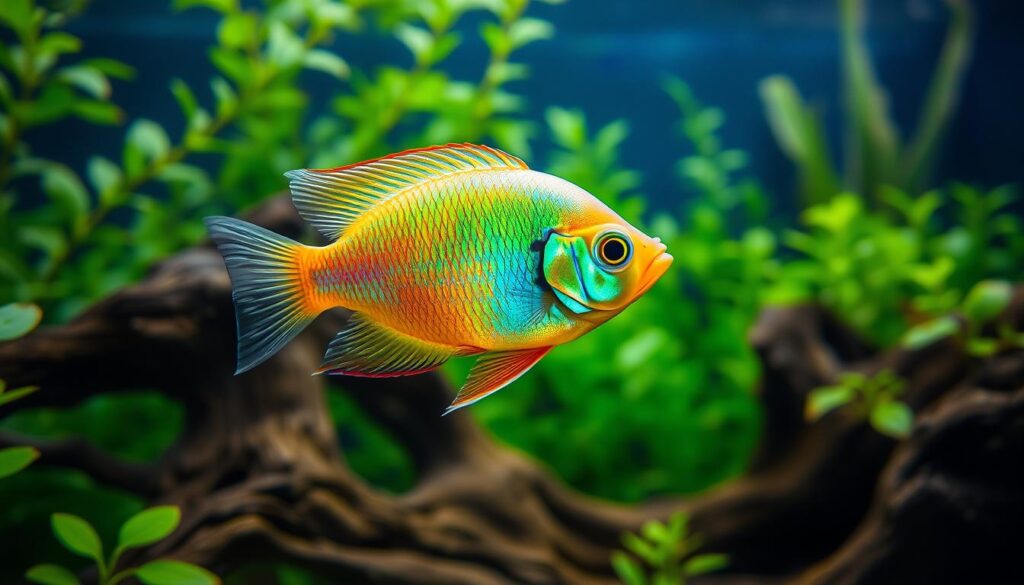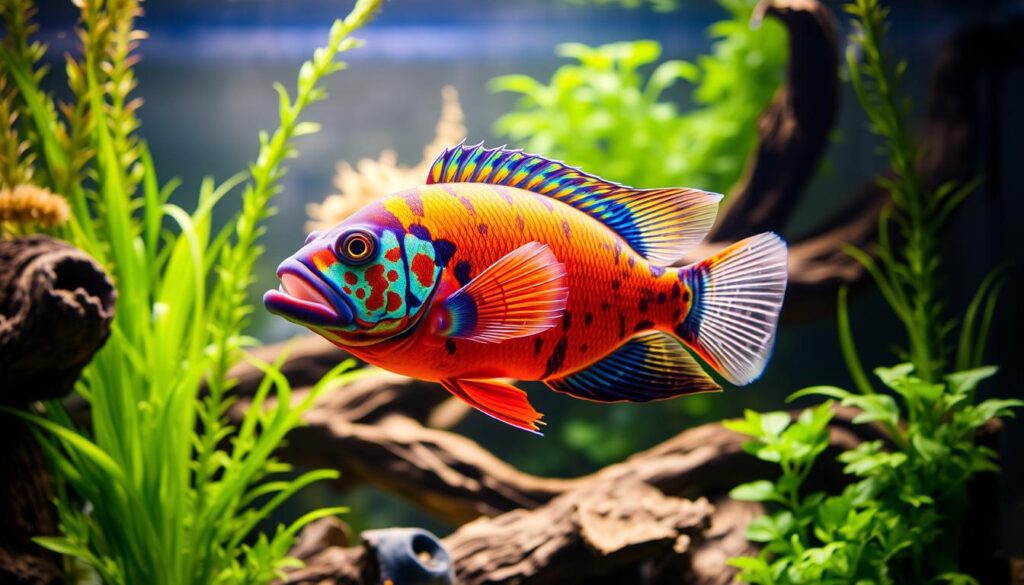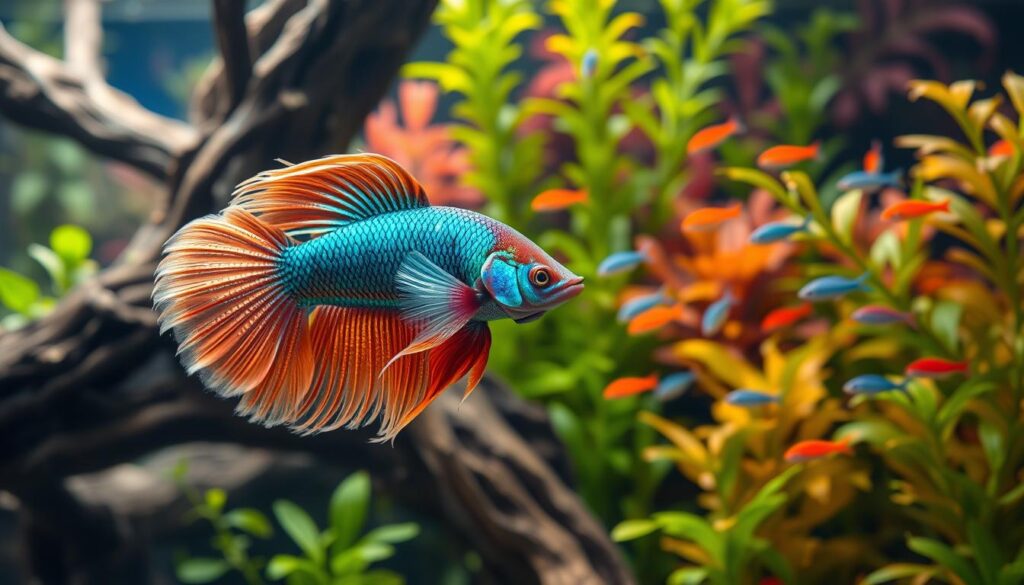Creating a visually appealing and peaceful tank starts with choosing the right centerpiece fish for freshwater community aquarium setups. These standout fish not only add vibrant color and personality to your aquarium but also bring balance and harmony to the aquatic environment.
Whether you’re a beginner or an experienced aquarist, picking the perfect centerpiece can transform your tank into a living masterpiece. In this guide, we’ll explore the top choices that will captivate your attention and thrive alongside other community fish.
So, what makes a great centerpiece fish? It’s all about choosing a fish that adds visual appeal and creates a focal point in your aquarium, while being compatible with your other aquatic friends. By selecting the right centerpiece fish, you can elevate your aquarium to a whole new level!
Key Takeaways
- Choose a centerpiece fish that stands out with its color or size.
- Ensure the centerpiece fish is compatible with other fish in your tank.
- A centerpiece fish can add visual appeal and create a focal point.
- Research different species to find the perfect centerpiece fish.
- Consider the size of your tank when selecting a centerpiece fish.
What Are Centerpiece Fish and Why Your Aquarium Needs One
A stunning centerpiece fish is the crown jewel of any freshwater community tank. It draws the eye and captures the imagination. When setting up or revamping your aquarium, the right centerpiece fish can make a big difference.
Defining the Role of Centerpiece Fish in Community Tanks
Centerpiece fish are usually the largest or most striking in your tank. They act as the focal point, with other fish and decorations arranged around them. They add elegance and sophistication, making your aquarium a true showstopper.
Benefits of Adding a Standout Species to Your Aquarium
Adding a standout centerpiece fish creates a visually appealing display. This is especially beneficial if you’re showcasing your aquarium in a living room or office. A well-chosen centerpiece fish can spark conversations and become a beloved conversation starter.
How Centerpiece Fish Create Visual Hierarchy
A centerpiece fish helps establish a visual hierarchy in your tank. It guides the viewer’s eye through the aquarium. By choosing a fish with striking colors or patterns, you create a natural focal point. This adds depth to your underwater landscape.
Understanding the role and benefits of centerpiece fish helps you create a captivating aquarium. It showcases your personality and style.
Key Considerations Before Selecting Centerpiece Fish for Freshwater Community Aquarium
Before you start looking for centerpiece fish, there are important things to think about. Picking the right centerpiece fish species for freshwater tank can seem hard. But with the right advice, you can make a stunning centerpiece for your tank.
Tank Size Requirements
The size of your tank is key when choosing a centerpiece fish. A bigger tank is more stable and gives your fish room to grow. For example, a centerpiece fish like the Freshwater Angelfish needs at least a 20-gallon tank. Smaller tanks are okay for smaller fish, but make sure you have enough room for them to grow.
Read Also Beginner’s Guide to Adding Live Plants in an Aquarium
Water Parameter Compatibility
Different fish need different water conditions like pH, hardness, and temperature. It’s crucial to pick a top centerpiece fish for community tank that fits your water setup. For example, tropical fish need warm water. Researching your fish’s needs will help you make a good choice.
Temperament and Community Compatibility
The fish’s temperament is as important as its looks. Some fish are too aggressive for a community tank, while others are peaceful. When picking a centerpiece fish, think about its personality and how it will get along with others. This ensures a peaceful aquarium.
By thinking about these points, you can pick a centerpiece fish that looks great and does well in your tank. This will make your aquarium a beautiful and balanced place.
Colorful Gouramis: Elegant Centerpiece Options
Colorful gouramis are a great choice to add elegance to your freshwater tank. They are stunning and bring peace to your aquarium. You can pick the perfect gourami to fit your tank’s unique style.

Pearl Gourami (Trichogaster leeri)
The Pearl Gourami is loved for its shiny scales and detailed patterns. It’s adaptable, hardy, and slightly territorial. This makes it a great centerpiece fish. With the right care, Pearl Gouramis do well in community tanks.
Dwarf Gourami (Trichogaster lalius)
Dwarf Gouramis are popular in community aquariums. They are small, colorful, and come in many colors. But, they can be territorial. So, make sure to add lots of hiding spots and plants to keep them calm.
Honey Gourami (Trichogaster chuna)
Honey Gouramis are bright orange and very peaceful. They are easy to care for and do well in small schools. They add a lively touch to your aquarium.
Care Requirements for Gourami Species
Gouramis are easy to care for but have specific needs. Here are some important care tips:
- Give them a tank with lots of space to swim and places to hide.
- Keep the water temperature between 72°F to 82°F (22°C to 28°C).
- Make sure the water is clean and full of oxygen.
- Feed them a mix of meaty and vegetable foods.
By following these care tips and picking the right gourami, you can enjoy their beauty in your aquarium.
Striking Cichlids for Community Setups
Looking for a fish that stands out in your community tank? Consider the vibrant world of cichlids! These fish can add color and personality to your aquarium. When choosing cichlids as centerpiece fish for your community fish tank, pick species that get along with others and don’t cause trouble.

Bolivian Ram (Mikrogeophagus altispinosus)
The Bolivian Ram is a great choice for a community tank. They have a unique personality and are mild. They won’t bother other fish, making them perfect for a peaceful aquarium. Bolivian Rams do well alone or in pairs and are easy to care for.
Read Also Can You Have Too Many Plants in an Aquarium? Here’s What Every Aquarist Should Know
German Blue Ram (Mikrogeophagus ramirezi)
German Blue Rams are stunning and can add interest to your tank. They have vibrant blue colors and intricate patterns. But, they can be territorial, so make sure to provide hiding spots and enough space.
Kribensis (Pelvicachromis pulcher)
Kribensis, also known as Pelvicachromis pulcher, are popular in community aquariums. They’re small, peaceful, and colorful. Kribensis like to hide in plants and rocks.
Keyhole Cichlid (Cleithracara maronii)
The Keyhole Cichlid is a peaceful, slow-moving fish. They have a unique “keyhole” marking and can grow large. Keyhole Cichlids are easy to care for and do well in planted tanks.
| Cichlid Species | Temperament | Tank Requirements |
|---|---|---|
| Bolivian Ram | Mild, peaceful | 30 gallons, plants, rocks |
| German Blue Ram | Generally peaceful, territorial | 20 gallons, hiding places |
| Kribensis | Peaceful, cave-dwellers | 20 gallons, plants, rocks |
| Keyhole Cichlid | Peaceful, slow-moving | 30 gallons, well-planted |
When adding cichlids to your tank, research their needs and make sure they fit with your fish. With the right choices, cichlids can be a great centerpiece fish for your community fish tank, adding beauty and interest.
Elegant Angelfish and Discus Options
Elegant and majestic, angelfish and discus are perfect for a freshwater community tank. They are stunning and add sophistication to any aquarium.

Freshwater Angelfish (Pterophyllum scalare)
Angelfish come from the Amazon Basin. They are known for their unique beauty and tall presence. They need lots of vertical space in the tank.
Care Requirements: Angelfish like warm, slightly acidic water. They need a varied diet, including live or frozen foods. They do well in tanks with plants and hiding spots.
Discus Fish (Symphysodon spp.)
Discus fish are famous for their vibrant colors and unique shape. They are a bit harder to care for than angelfish. They need very clean, warm water with exact parameters.
Nutritional Needs: Discus need a diet rich in protein and variety. They should eat high-quality flake foods and frozen meaty foods. They are very sensitive to water quality, so regular water changes are key.
Special Considerations for These Delicate Centerpieces
Both angelfish and discus are sensitive to water conditions. They need a well-maintained tank. They do best in aquariums with stable water and plenty of hiding spots to reduce stress.
“The key to keeping angelfish and discus healthy is maintaining pristine water conditions and providing them with a balanced diet.”
| Fish Type | Tank Requirements | Dietary Needs |
|---|---|---|
| Angelfish | Ample vertical space, plants, and hiding places | Varied diet including live/frozen foods |
| Discus | Clean, warm water with precise parameters | High-protein diet, regular water changes |
By understanding and meeting the specific needs of angelfish and discus, you can enjoy these beautiful fish as the centerpiece of your freshwater community aquarium.
Best Centerpiece Fish for Freshwater Community Aquarium: Unique and Unusual Species
Looking for something different? There are many unusual centerpiece fish for your freshwater community aquarium. These unique species can make your tank more interesting and beautiful.

Paradise Fish (Macropodus opercularis)
The Paradise Fish is a vibrant choice with stunning colors and fins. It comes from Asia and can be territorial. So, make sure your tank has enough space and hiding spots.
Care Requirements: Keep the water between 64°F to 82°F (18°C to 28°C) and pH 6.5-8.5. A 20-gallon tank is the minimum size needed.
Betta Fish (Betta splendens)
The Betta Fish is our top pick for a centerpiece! Their half-moon tails and flowy fins are breathtaking. But, to prevent fin nipping, choose the Plakat Betta or Betta Pugnax with shorter fins.
“Betta fish are not just for small bowls; they can thrive in a well-planted community tank with proper care.”
Care Requirements: They need warm water between 76°F to 82°F (24°C to 28°C) and pH 6.5-8. A 20-gallon tank is best for community setups.
Killifish Species (Aphyosemion and Fundulopanchax)
Killifish come in many colors and patterns. They’re a bit tricky to care for because of their specific water needs. But, the effort is worth it.
| Species | Temperature | pH |
|---|---|---|
| Aphyosemion | 72°F – 82°F (22°C – 28°C) | 6.0 – 7.0 |
| Fundulopanchax | 75°F – 82°F (24°C – 28°C) | 6.5 – 7.5 |
Peacock Gudgeon (Tateurndina ocellicauda)
The Peacock Gudgeon is a peaceful, small fish that adds color to your tank. Males are especially colorful, showing a peacock-like pattern.
Care Requirements: They need water between 72°F to 82°F (22°C to 28°C) and pH 7.0-8.0. A 10-gallon tank is the minimum size needed.
Creating the Ideal Environment for Your Centerpiece Fish
Your centerpiece fish needs a special place to call home. Let’s explore how to make a perfect environment for it! A well-designed freshwater aquarium is a feast for the eyes. It features beautiful plants, detailed aquascapes, and centerpiece fish species for freshwater tank swimming together.
Aquascaping to Highlight Your Featured Fish
Aquascaping is key to making your aquarium look great. It combines plants, rocks, and driftwood to create a natural setting. Think about your fish’s natural home when designing. For example, if your fish loves dense plants, add lots of them!
Lighting Considerations
Lighting is important for showing off your centerpiece fish. The right lights can make their colors pop and change the aquarium’s mood. LED lights are popular because they save energy and can be set to different colors. Try out different lighting setups to find the best one for your fish!
Providing Proper Hiding Places and Territories
Just like in the wild, your fish needs places to hide and claim as their own. Use plants, rocks, and decorations to create these spots. This helps reduce stress and lets your fish act naturally, making your tank more interesting!
Water Quality Management for Centerpiece Species
| Parameter | Ideal Range | Impact on Centerpiece Fish |
|---|---|---|
| pH | 6.5-8.5 | Affects fish comfort and stress levels |
| Ammonia | 0 ppm | Toxic to fish; can cause illness or death |
| Nitrite | 0 ppm | Toxic to fish; can cause illness or death |
| Nitrate | <20 ppm | High levels can lead to algae growth and stress |
Keeping the water quality right is crucial for your fish’s health. Regular water changes, good filtration, and checking the water’s condition are essential. This ensures your aquarium is a happy place for your fish.
Compatibility Guide: Pairing Your Centerpiece Fish with Community Tank Mates
Choosing the right tankmates for your centerpiece fish is key to a thriving community tank. A balanced aquarium not only highlights your centerpiece fish but also creates a peaceful home for all.
Suitable Tankmates for Semi-Aggressive Centerpiece Species
For semi-aggressive centerpiece fish, pick tankmates that can hold their own. Robust species like danios or white cloud mountain minnows are good choices. They’re active and can live peacefully together. Stay away from fin-nippers or very shy fish that might get bullied.
Companions for Peaceful Centerpiece Fish
Peaceful centerpiece fish, like Honey Gourami or Bolivian Ram, can be paired with calm tankmates. Neon tetras, harlequin rasboras, or small catfish are great options. They like to school or stay low, which reduces stress and competition.
Species to Avoid Mixing with Popular Centerpiece Fish
Some fish don’t get along with popular centerpiece fish. For example, many centerpiece fish might eat freshwater shrimp. But, if you have peaceful fish like Honey Gouramis or Bolivian Rams, your shrimp might survive. Also, avoid mixing fin-nippers with long-finned fish to prevent trouble.
Conclusion: Selecting the Perfect Centerpiece Fish for Your Aquarium
Finding the perfect centerpiece fish for your aquarium is an exciting journey. It ends with a beautiful space that draws admiration and curiosity. We’ve looked at how the right centerpiece fish can make your aquarium stand out.
Think about your tank’s size, water needs, and the fish’s personality. This helps you pick a centerpiece fish that will do well in your aquarium. You might want the grace of angelfish, the color of gouramis, or the charm of killifish. There’s a perfect fish for you.
Start your underwater adventure by making a space that shows off your centerpiece fish. With the right care, your chosen fish will be the highlight of your aquarium. It will bring happiness and peace to your aquatic world.

